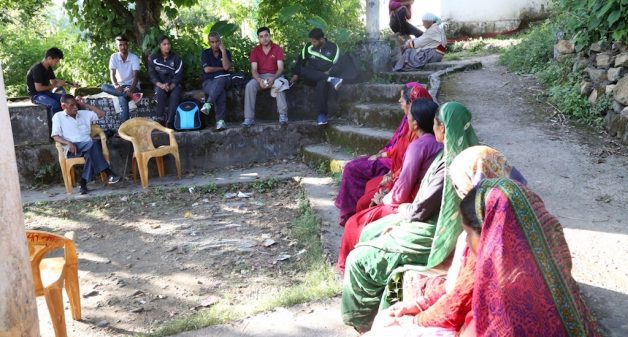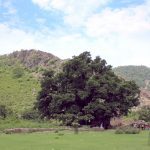Not long ago, Pithoragarh district in the Himalayan state of Uttarakhand was fed by a network of perennial springs locally called chasmas. It was a well-integrated natural system on which the people depended round the year. All that is changing now and water stress during summer months has become common for the far-flung villages.
A visit to the Gorang Valley, some 10 km from Pithoragarh town, was revealing. The valley, drawing its name from horses that once grazed on its sloping meadows, is still beautiful although much of the old forest cover has given way to farming and other human incursions. The rolling lush beauty camouflages an ugly side, the water woes faced by villages in summers.
Nakina village on the right flank of Gorang valley is 6-7 km from Chandak, where the valley begins and winds down for a further 15 km. The Gorang valley has 53 springs. During peak summers, many of them are reduced to a mere trickle or dry up completely. The drive to Nakina passes through thick forests of oak, pine and some rhododendron.
Water crisis
Jagdamba Prasad, chief of Nakina’s village council, and a few women residents recount that water crisis they face every summer. “In summers all our seven springs dry up. Our whole day is spent in collecting water. Water for washing and bathing becomes a luxury,” the women say. While half of the villagers go to the river about a kilometer away, the other half goes to the next village that has a spring 2 km away. Summers are backbreaking for the women and girls as they have the basic responsibility for fetching water. Nakina now has some 50 households, down from about 200 about a decade ago.
The rest, leaving behind their homes and land, have fled to greener pastures. Yet the summer water crisis in Nakina has only worsened over the years. Nobody knows why exactly despite the lush surrounding forests. A few handpumps in the village would be a great boon, but drilling machines cannot be transported down to these hilly villages.
Reviving the springs
The GB Pant National Institute of Himalayan Environment and Sustainable development (GBPIHESD) and its civil society partners have started working with the villagers, making efforts to revive the springs. Like Nakina, Digtoli village, situated behind the steep mountain towering above Nakina, faces a similar problem. From the road above Nakina, it is a 15 minute drive to Digtoli past a majestic 300 year old oak tree that once identified the village from distant mountains. Digtoli also offers a panoramic view of the Himalayan range, and the Nanda Devi and Panchachuli peaks.

Opposite Digtoli, clambering uphill one can see troughs dug and saplings planted along the hillside to reduce rainwater runoff and reduce soil erosion through plantations. Digtoli’s 70-odd households scattered among the slopes depend on 13 springs. In peak summers most of them dry up, except one downhill, which is called Shivalaya. Without water peak summers are difficult to endure. P.C Patni, an old villager, says, “There have been minor changes since the water conservation efforts have begun. People are now also contemplating rainwater harvesting at the individual level.’”
Slow trickle
The idea of conserving water is slowly trickling down. Yogesh Barola, a young geologist working in the area, says how the current spring and watershed management efforts will take time to make a visible impact. Reacting to skepticism, he says, “It is a precise science, geological and hydrological mapping that feed into spring recharging efforts. New oak plantations will also augment water conservation efforts.” Oaks, locally called banj, are known to conserve water.
Circumventing Digtoli, there’s a steep climb over the village past the local primary school. On reaching further up, one notices gashes and trenches dug up along the slope. These have been made for directing rainwater into large troughs or dug wells that store water and recharge the groundwater. The collected water also quenches the thirst of cattle and horses grazing on the hill slopes.
After more climbing one reaches a cusp, a meadow called the Antola depression. Nakina’s Jagdamba Prasad is waiting here. The former army man shows an artificial embankment dug up by people from his village. “It was voluntary work done over several weeks,” he says. The district administration has promised to release some funds for the work, he adds.
Eventual recharge
The embankment will store a considerable amount of water that will eventually recharge some 20-25 springs that serve five villages on either side of the so-called water tower. But it will not help reach the springs of Nakina whose people have dug the trench.
For them, on the upper reaches of the depression, Prasad shows another artificial embankment built by the villagers. Rain-fed, this resulting lake will in subsequent years feed the springs in Nakina and nearby Bhurmuni villages.
It could be a long parched wait in summers, as long as 7-8 years, says Rajesh Joshi, lead scientist from GBPIHESD who is overseeing the spring shed management. “The soil here is porous, so water does not stand for very long; it seeps down. Small changes are already visible, though, like there is reduced soil erosion along the drainage channel. Less erosion will mean lesser chances of the road being blocked by landslides,” he says.
To speed up the spring recharging efforts, Ranbeer Rawal, senior scientist of the Almora-based GBPIHESD says, “We have shared our spring shed management plans with various line departments. We offer scientific inputs and linkages to various government departments for a holistic approach.”
Women pressure
But the bulk of the pressure to get the work going comes from the community itself particularly the women, who have formed self-help groups. “We approach the officials from time to time. They listen to us. We are hopeful our water problem in summers will be solved. Yes, the wait might be a little long,” says Gita Joshi, 37, a resident of Nakina village.
But Prasad, now into his eighties, has little patience. “Between April and June, life becomes hell here. The government should lift water from the river through a pump, at least during the summer months,” he says.
Ashim Choudhury is a Delhi-based writer.








